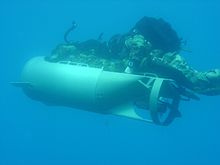This article needs additional citations for verification. (September 2018) |


A diver propulsion vehicle (DPV), also known as an underwater propulsion vehicle, sea scooter,[1] underwater scooter, or swimmer delivery vehicle (SDV) by armed forces, is an item of diving equipment used by scuba divers to increase range underwater. Range is restricted by the amount of breathing gas that can be carried, the rate at which that breathing gas is consumed, and the battery power of the DPV. Time limits imposed on the diver by decompression requirements may also limit safe range in practice. DPVs have recreational, scientific and military applications.
DPVs include a range of configurations from small, easily portable scooter units with a small range and low speed, to faired or enclosed units capable of carrying several divers longer distances at higher speeds.
The earliest recorded DPVs were used for military purposes during World War II and were based on torpedo technology and components.
